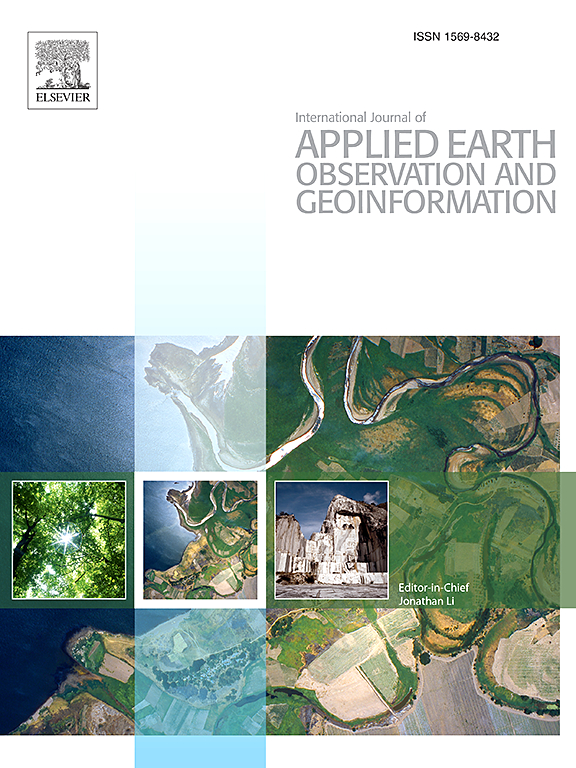一种重力启发模型,整合地理空间和社会经济距离,用于卡车始发目的地流量预测
IF 7.6
Q1 REMOTE SENSING
International journal of applied earth observation and geoinformation : ITC journal
Pub Date : 2025-02-01
DOI:10.1016/j.jag.2024.104328
引用次数: 0
摘要
准确预测货车始发地流量对优化物流系统、促进区域协调发展具有重要意义。现有方法通常假设卡车外径流随地理空间距离的增加而单调减小,这过于简化了实践中观察到的复杂的非单调分布模式。此外,这些方法忽略了区域间社会经济距离及其与地理空间距离的相互作用,从而限制了预测的准确性和可靠性。本研究引入了一个重力启发的模型,该模型整合了地理空间和社会经济距离(GSD-DG),以明确表示它们对卡车外径流量的综合影响。具体而言,我们1)利用威布尔函数建立了一个地理空间距离关系图,以模拟不同地理空间距离下卡车外径流的复杂空间分布格局;2)提出了一种基于图注意机制的重力启发表征学习方法,量化社会经济距离对卡车OD流量的影响;3)构建一个整合这些距离及其相互作用的深度重力模型,以捕捉它们与卡车外径流的非线性关系。在不同空间尺度和经济发展水平的4个数据集上进行的大量实验表明,GSD-DG模型在不同空间分布格局下的稳健性和预测精度均有所提高,与6个基线模型相比,RMSE降低14.2% ~ 85.8%,MSE降低23.5% ~ 92.5%。考虑社会经济距离及其与地理空间距离的相互作用,RMSE进一步降低8.5% ~ 36.0%。此外,可解释的人工智能技术强调了这些距离如何影响卡车外径流,为物流规划和协调区域发展提供了有价值的政策见解。本文章由计算机程序翻译,如有差异,请以英文原文为准。
A gravity-inspired model integrating geospatial and socioeconomic distances for truck origin–destination flows prediction
Accurately predicting truck origin–destination (OD) flows is essential for optimizing logistics systems and promoting coordinated regional development. Existing methods typically assume a monotonic decrease in truck OD flows with increasing geospatial distance, which oversimplifies the complex non-monotonic distribution patterns observed in practice. Moreover, these methods overlook interregional socioeconomic distances and their interaction with geospatial distances, thereby limiting the prediction accuracy and reliability. This study introduces a gravity-inspired model that integrates both geospatial and socioeconomic distances (GSD-DG) to explicitly represent their combined influence on truck OD flows. Specifically, we 1) develop a geospatial distance relation graph using the Weibull function to model the complex spatial distribution patterns of truck OD flows with varying geospatial distances; 2) propose a gravity-inspired representation learning method based on graph attention mechanism to quantify the influence of socioeconomic distance on truck OD flows; and 3) construct a deep gravity model that integrates these distances and their interactions to capture their non-linear relationship with truck OD flows. Extensive experiments on four datasets with varying spatial scale and economic development levels demonstrate that the GSD-DG model improves the robustness and prediction accuracy across diverse spatial distribution patterns, reducing RMSE by 14.2%–85.8% and MSE by 23.5%–92.5% compared to the six baseline models. Incorporating socioeconomic distance and its interaction with geospatial distance further reduces RMSE by 8.5%–36.0%. Additionally, explainable artificial intelligence techniques highlight how these distances affect truck OD flows, providing valuable policy insights for logistics planning and coordinated regional development.
求助全文
通过发布文献求助,成功后即可免费获取论文全文。
去求助
来源期刊

International journal of applied earth observation and geoinformation : ITC journal
Global and Planetary Change, Management, Monitoring, Policy and Law, Earth-Surface Processes, Computers in Earth Sciences
CiteScore
12.00
自引率
0.00%
发文量
0
审稿时长
77 days
期刊介绍:
The International Journal of Applied Earth Observation and Geoinformation publishes original papers that utilize earth observation data for natural resource and environmental inventory and management. These data primarily originate from remote sensing platforms, including satellites and aircraft, supplemented by surface and subsurface measurements. Addressing natural resources such as forests, agricultural land, soils, and water, as well as environmental concerns like biodiversity, land degradation, and hazards, the journal explores conceptual and data-driven approaches. It covers geoinformation themes like capturing, databasing, visualization, interpretation, data quality, and spatial uncertainty.
 求助内容:
求助内容: 应助结果提醒方式:
应助结果提醒方式:


